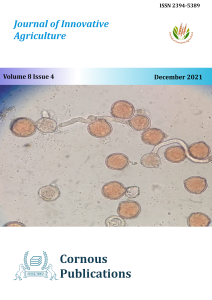
Journal of Innovative Agriculture
Peer Reviewed Open Access Journal
ISSN: 2394-5389 NAAS: 4.05
Submit Manuscript
Peer Reviewed Open Access Journal
ISSN: 2394-5389 NAAS: 4.05
Submit ManuscriptOPEN ACCESS | Published on : 31-Dec-2021 | Doi : 10.37446/jinagri/rsa/8.4.2021.1-7 | Pages : 1-7
OPEN ACCESS | Published on : 31-Dec-2021 | Doi : 10.37446/jinagri/rsa/8.4.2021.8-13 | Pages : 8-13
OPEN ACCESS | Published on : 31-Dec-2021 | Doi : 10.37446/jinagri/rsa/8.4.2021.14-19 | Pages : 14-19
OPEN ACCESS | Published on : 31-Dec-2021 | Doi : 10.37446/jinagri/rsa/8.4.2021.20-29 | Pages : 20-29
OPEN ACCESS | Published on : 31-Dec-2021 | Doi : 10.37446/jinagri/rsa/8.4.2021.30-35 | Pages : 30-35
OPEN ACCESS | Published on : 31-Dec-2021 | Doi : 10.37446/jinagri/rsa/8.4.2021.36-42 | Pages : 36-42
OPEN ACCESS | Published on : 31-Dec-2021 | Doi : 10.37446/jinagri/rsa/8.4.2021.43-46 | Pages : 43-46
